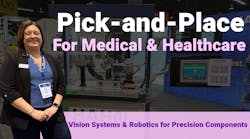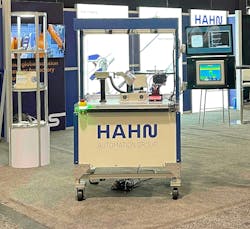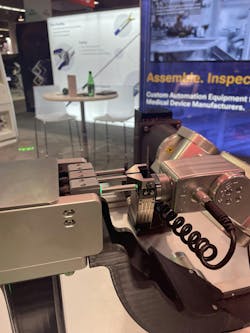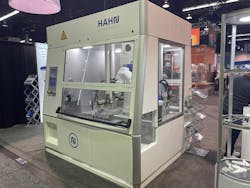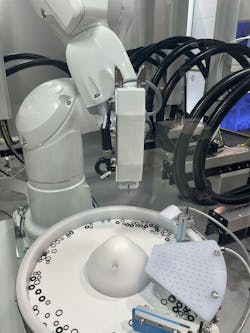Two Demonstration Machines Address Multiple Medical Device Manufacturing Competencies
At a Glance:
- Hahn Automation Group combined its experience in MedTech manufacturing with the capabilities of partners to create a demonstration that performs more than 13 complex manufacturing processes in a single cell that is less than 420 cubic feet.
- A vision systems and robotics demonstration for handling precision components such as stents.
As medical devices become smaller and more complex, automation solutions continue to be a critical factor in helping MedTech manufacturers achieve precision, efficiency and scalability. Hahn Automation Group, a leader in end-to-end automation systems, has developed two demonstration machines that showcase the potential of advanced automation in medical device production. These systems address key challenges faced by manufacturers and offer innovative solutions to improve productivity, quality and flexibility.
Dual-Sided Assembly and Test Solutions: Maximizing Flexibility and Efficiency
This first system showcases a dual-sided assembly and test solution that integrates various technologies from MedTech device manufacturing and medical plastics material handling. This system demonstrates Hahn Automation Group’s focus on flexibility, precision and efficient use of valuable floor space.
Innovative Design and Capabilities
The dual-sided system features:
Multi-product flexibility. One side of the demonstration system is dedicated to COC (Cyclic Olefin Copolymer) syringe assembly, while the other handles pacemaker assembly, showcasing adaptability to different product requirements. In an actual production environment, a system like this would allow for multiple product types and/or the combination of assembly and test functionality on the same piece of equipment.
READ MORE: A Showcase of Innovations Turns Heads at MD&M West
Advanced motion control. The cell features a multi-carrier magnetic system as well as a flexible link conveyor system—both offering ideal transport in cleanroom applications.
Efficient space utilization. The innovative carrying approach improves operational dynamics by enabling multidirectional transport, allowing multiple functions with a single piece of equipment. In real-world applications this would significantly minimize footprint, risk and cost.
Syringe Handling Process
The syringe handling side of the system demonstrates comprehensive assembly, material handling and quality control capabilities. Here’s how it works:
- At the first station, the syringes are moved either from left-to-right or from right-to-left via the multi-directional carrier.
- Once positioned, a sensor verifies part presence and performs a series of measurements.
- The carrier moves the syringes across multiple stations that simulate plasma activation of inner surfaces and silicone oil coating.
- Finally, a handling unit performs plunger placement and removal.
Pacemaker Assembly Process
The pacemaker assembly side showcases a complex assembly procedure:
- O-rings of varying sizes are loaded into a FlexiBowl feeder where they are separated and picked by a Stäubli robot and inserted into the housing of a demonstration pacemaker located in the first station.
- The pallet is moved by the carrier to a vision system that confirms the placement of the O-ring.
- The system then moves to an adhesive station where the machine simulates dispensing and UV curing.
- The multi-directional carrier then moves the assembled device back to the vision system for a final inspection.
Maximizing Technology Integration
This demonstration system integrates technologies from industry leaders such as FESTO, Siemens, KEBA, Stäubli, AFAG, ARS FlexiBowl, Keyence and Schunk—demonstrating just a few of the established partnerships that help to advance the overall solution.
By combining the capabilities of these providers with Hahn’s 30+ years of experience in MedTech manufacturing, the demonstration highlights how manufacturers can perform more than 13 complex manufacturing processes in a single cell that is less than 420 cubic feet.
Vision Systems and Robotics for Precision Components
Hahn Automation Group’s second showcase system highlights the use of vision systems and robotics for handling precision components such as stents. This machine addresses four key questions frequently asked by medical device manufacturers:
How to Determine the Right Level of Automation
The system demonstrates a semi-automated production line station, balancing operator involvement with automation. This approach is often ideal for processes that require human interaction but involve delicate materials or tedious tasks that are prone to error.
In this demonstration system, the stents have features such as varying ID/OD (inner diameter/outer diameter) that are hard to detect with the human eye, thus the vision system and robotic components help ensure the parts are placed accurately.
READ MORE: IO-Link Masters: Enabling Sensors and Devices to Communicate Through Software
How to Adjust Product Design for the Use of Vision Systems
Hahn’s involvement throughout the product development process in real applications allows for flexibility as products evolve—providing tips that may improve manufacturability.
The demonstration system highlights this capability with features such as:
- Filters and backlighting during pick-and-place operations that allow cameras to detect stents regardless of orientation
- Measurement sensors for outer and inner diameter verification
- Geometric analysis of post-production notches to confirm stent orientation
How to Improve Operator Productivity and Consistency
By automating error-prone tasks, the system significantly enhances operator productivity and consistency. This targeted approach to automation focuses on processes that are both susceptible to errors and suitable for machine handling.
In the demonstration equipment, the stents are marked with words that form a statement when placed correctly onto LED bars. The vision system helps ensure the words are right-side-up and in the correct order. In a MedTech application, the words may represent a pin or a blade—any component where both placement and orientation are critical to the function of the device.
How to Leverage Production Scale-up Strategies
The root of scaling-up production is always to evaluate the goal manufacturers are trying to achieve—time, quality or capability.
The system demonstrates how automation can impact each of these through:
- Reduction of errors and rejects, naturally improving cycle times.
- Faster processing in a smaller footprint compared to manual operations.
- Automation of tasks that machines can perform more efficiently than humans.
Achieving Scale Through Cutting-Edge Technologies
Hahn Automation Group’s innovative demonstration systems showcase the potential of advanced automation in medical device manufacturing. By addressing key industry challenges and integrating cutting-edge technologies, these solutions pave the way for more efficient, precise and scalable production processes. As the medical device industry continues to evolve, Hahn Automation Group remains at the forefront, providing manufacturers with the tools they need to stay competitive in an increasingly demanding market.
